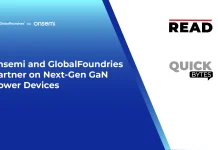Marvell Technology, Inc., a leader in data infrastructure semiconductor solutions, has delivered two optical PAM4 digital signal processors (optical DSPs) to enable cloud operators to serve the exploding demand for AI, accelerated computing and cloud services by optimizing the performance, bandwidth and efficiency of the optical links connecting data infrastructure.
Sampling to select customers now, Perseus is the industry’s first 400/800 Gbps 5nm device that monolithically integrates the primary electrical components of a short-reach pluggable optical module an optical DSP, a transimpedance amplifier (TIA) and a vertical-cavity surface-emitting laser (VCSEL) driver into a single die to reduce power, space and cost. Monolithically integrating components also reduces manufacturing complexity for module manufacturers to enable them to scale faster. Perseus is also available with an integrated silicon photonics driver.
Perseus is optimized for both active optical cables (AOCs), which replace passive copper cables for connecting equipment within racks, and short-reach single mode and multi-mode optical interconnects for distances of five to 500 meters.
Meanwhile, the Marvell® Spica Gen2, which began sampling in late 2022 and is now in volume production, is an 800 Gbps 5nm optical DSP optimized for longer-reach connections such as the high-bandwidth optical connections linking servers within an AI cluster or the optical connections between racks in a hyperscale data center. Spica Gen2 enables pluggable optical module manufacturers to reduce the power consumption of products to below 12 watts, a 25% savings over the previous generation of devices.1
Also Read : Kyocera Avx Vcas Series Mlvs Are Now Qualified To Vw80808
Both chips are the latest products in a growing portfolio of optical and copper connectivity chips from Marvell optimized for specific use cases to help cloud operators maximize the utilization and performance of their infrastructures while reducing overall cost and power per bit. Both Perseus and Spica Gen2 are based on the Marvell industry-leading PAM4 optical DSP architecture, the most widely deployed optical DSP in cloud data centers and AI clusters.
“AI is impossible without optical,” said Vlad Kozlov, CEO and founder of LightCounting, which forecasts that shipments of 800 Gbps and faster optical modules to the cloud will grow from 3 Exabits/second to 19 Exabits/second by 2027, a 78% CAGR. “Marvell has long been at the forefront of expanding the applications and use cases for optical inside data centers. Perseus and Spica Gen2 represent the latest steps in that voyage.”
Connecting the Cloud
Optical DSP modules convert electrical signals from switches or other devices so data traffic can move to faster, more efficient and higher bandwidth optical networks. A mainstay in data centers since the early 2000s, optical modules have achieved a 1000x increase in data rate and a 100x reduction in energy per bit.2 The majority of connections within data centers over five meters today are made with optical DSP modules.2
Doubling in bandwidth approximately every two years, optical DSP-based modules are growing at approximately 54% per year in terms of bits shipped,3 enabling the 40-50% annual growth of bandwidth traffic at cloud service providers.3
The rise of accelerated computing will further fuel innovation in optical DSP technology as cloud service providers seek to scale their infrastructure to meet surging customer demand as well as the escalating performance requirements of these new, complex workloads. Some AI training clusters, for example, can contain up to 32,000 processors, 2,000 switches, 70,000 optical DSP modules and consume up to 45 megawatts of power.4
To help cloud operators and others increase their return on investment, Marvell produces connectivity products fine-tuned for different connectivity applications and use cases. Perseus, for example, supports both full retimer use cases for modules requiring both transmit and receiver capabilities as well as transmit-only or receiver-only half retimer use cases such as linear pluggable optics (LPO). Other specialized products include Nova (the industry’s first 1.6T optical DSP for medium- to long-reach connections inside data centers), Porrima (100-400G), coherent DSPs and modules for long-range connections (2-2,000km), and copper-based active electrical cable devices for server-to-server links.
“The optimized approach Marvell takes to silicon design gives us a platform for developing a broader portfolio of products,” said Osa Mok, chief marketing officer at InnoLight. “In the AI era, customers will obsessively seek performance and power gains in every part of their infrastructure. Specialized optical modules and technologies will allow them to achieve their goals in a scalable, economical manner.”
SOURCE : PRNewswire




